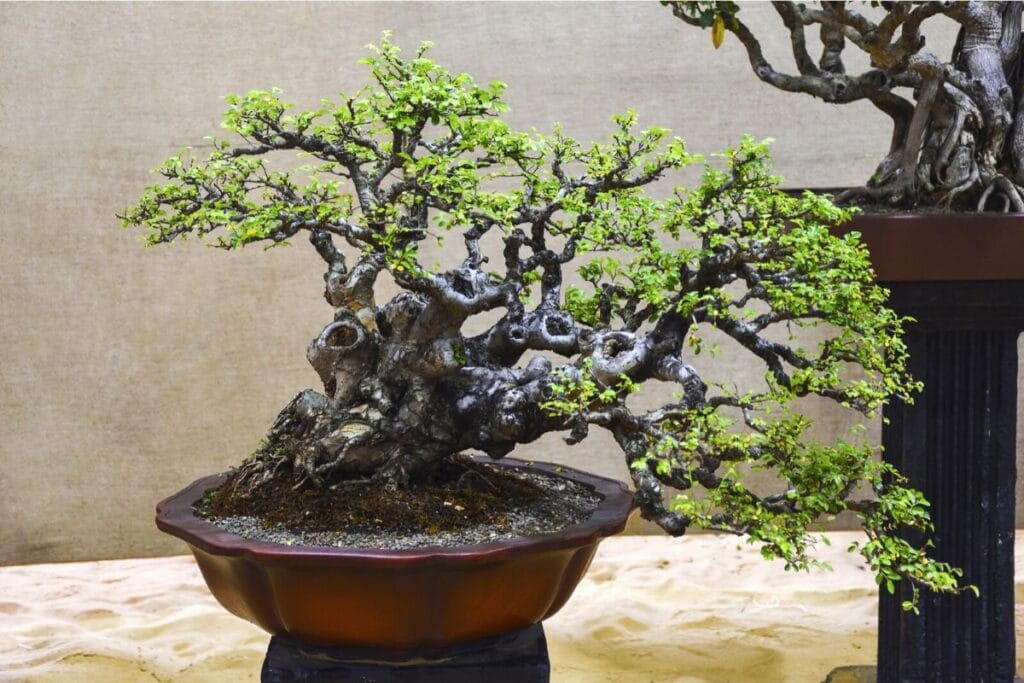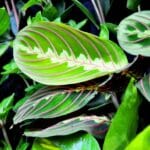Native to southeast Asia, the Chinese elm has a reputation as being a towering, statuesque tree. It can grow up to 80 feet tall, in fact, with a trunk diameter of more than three feet!
However, despite its massive size, this plant is also one of the most commonly cultivated as a bonsai species. This is because the plant develops small, delicate leaves that are absolutely lovely to behold in a more compact environment.
When pruned and shaped, the Chinese elm bonsai takes on a classical umbrella shape, making it a favorite among bonsai enthusiasts. Growing this tree is remarkably easy, and here’s how you can do it.
Interesting Facts about Chinese Elm Bonsai
Height: 8-10 inches
Width: 2 inches
Sunlight: Full sunlight
Flowering Time Length: Does not flower
Lifespan: 50+ years
Scientific name: Ulmus parvifolia
Types of Chinese Elm Bonsai
The Chinese elm is the most commonly chosen elm for bonsai. Other elms can also be used, but this plant produces some of the most beautiful foliage.
It is often confused with the Zelkova plant, but the difference is in the leaves. While Zelkova has single-toothed leaves, the Chinese Elm has double-toothed leaves.
Growing Chinese Elm Bonsai from Seed or By Propagation
Although Chinese elm bonsai can be grown from seed, it is more often propagated from cuttings. This can usually be done by beginners with limited problems.
How To Care for Chinese Elm Bonsai
Here are some bonsai caring tips you can follow:
Sunlight
Chinese elm bonsai tree can be grown both in full sun as well as in partial shade. If you live in a mild climate, you can easily let this tree remain outside throughout the year – including during the winter months.
You can also bring this bonsai plant indoors during the summer and winter months, but it’s best to keep it in a cool, frost-free room (like a cold garage).
The Chinese elm bonsai trees can withstand a little bit of frost, but it will ultimately depend on the hardiness of your plant as well as the region from which the tree was imported. While cultivars from northern areas of China seem to be more well-adapted to the old, those from southern areas are not quite as resilient.
Either way, you may find that your Chinese elm drops some of its leaves while it’s in winter dormancy.
Watering
Water your Chinese elm trees liberally, doing so as soon as the soil begins to dry out. It’s important that you avoid prolonged dry spells but also that you avoid prolonged wetness, which can cause issues with the roots of your miniature trees.
Root rot is a potential concern when the roots remain excessively wet for extended periods. To prevent this, ensure proper drainage and allow the soil to dry out between waterings.
Fertilizing
The Chinese elm should be fed well with a solid organic fertilizer (or a liquid chemical fertilizer) during the growing season. Do not feed your indoor bonsai while it is dormant in the winter. You don’t need to use very much fertilizer, nor do you need to use any special kind of fertilizer.
Potting and Repotting
You will want to repot your Chinese elm bonsai tree species every other year. Large or very old elms can be repotted less often.
The best time to repot your tree is in the early spring. You should carefully prune the roots, which can require a great deal of concentration.
The Chinese elm produces crooked, intertwined roots that need to be separated to the best of your abilities. While there are no special potting soil requirements, it does need to be well-draining. You can use any standard soil mixture to get the job done.
However, if you want to enhance the soil quality, consider incorporating peat moss into the mix. Peat moss helps improve moisture retention and provides additional nutrients for the tree’s health.
Pruning a Chinese Elm Bonsai
It’s a good idea to prune your Chinese elms on a regular basis. If left to its own devices, it will thicken rapidly. Therefore, you may want to trim your plant often, which will help to produce fresh buds. Let the shoots extend out to three or four nodes before pruning back to just one or two leaves. The best time to prune is in the late fall.
Pests and Diseases
The Chinese elm bonsai is generally hardy and resilient, but it may occasionally face some challenges. Among the pests that might trouble it, scale and spider mites are the most common. These issues tend to worsen in low-humidity conditions.
To combat spider mites, consider using a neem oil spray. Additionally, maintaining a regular misting schedule for your plant can effectively deter these pests and keep your bonsai healthy.
Where to Buy Chinese Elm Bonsai
You can purchase Chinese elm seeds from many online retailers, but you would be better off purchasing a starter plant from a specialty nursery. This will ensure you get a high-quality tree that is already trained to grow in a container.
FAQs
Can you keep Chinese elm bonsai indoors?
Yes, Chinese elm bonsai can be kept indoors, but they will require proper care to thrive. They benefit from being placed in a location with bright, indirect light and adequate humidity.
Why is my Chinese elm bonsai dying?
Chinese elm bonsai may be dying due to various factors such as overwatering, underwatering, inadequate light, pests, diseases, or environmental stress. Evaluate the plant’s care routine and growing conditions to identify and address any issues affecting its health.
Is Chinese elm bonsai easy to grow?
Chinese elm bonsai are generally considered to be easy to grow and are suitable for beginners. They are resilient plants that tolerate a wide range of growing conditions and respond well to proper care and maintenance.
Why is my Chinese elm bonsai losing leaves in the summer?
Chinese elm bonsai may lose leaves in the summer due to factors such as underwatering, overwatering, excessive heat, or sudden changes in environmental conditions.
*Photo by chinese elm bonsai/depositphotos







